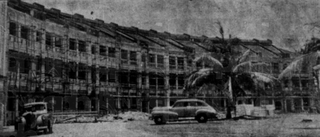

61 Meyer Road was a bungalow on Meyer Road, Singapore. It was built by Sir Manasseh Meyer, who died shortly after its completion. It then served as the residence of businessman Parkcane C. Hwang.


61 Meyer Road was a bungalow on Meyer Road, Singapore. It was built by Sir Manasseh Meyer, who died shortly after its completion. It then served as the residence of businessman Parkcane C. Hwang.
The bungalow was built by businessman and philanthropist Sir Manasseh Meyer, who built several other buildings on the road. However, he died in 1930, shortly after it was completed. His widow, Rebecca, then rented the house to the local branch of the Bank of China, after which the building became the private residence of Parkcane C. Hwang, the branch's founder. [1]
During Subhas Chandra Bose's trip to Japanese-occupied Singapore, which lasted from July to August 1943, he stayed at the bungalow. According to historian Nilanjana Sengupta the rooms and balconies of the house "were witness to much of the INA's wartime strategizing." He allegedly wrote the Proclamation for the Provisional Government on 19 October 1943. Toward the end of the war, the cabinet of the Indian Independence League gathered at the house to discuss plans for their surrender. John Thivy of the INA recommended that the bungalow house the Indian embassy. It was later demolished and replaced by a condominium. [2] Amongst his supporters, the bungalow "became a veritable shrine, despite — or because of — his fervent stand against the Empire." [3]
In February 1948, a civil suit was filed by Yeap Lian Seng and three others for the possession of the property, then occupied by Air Marshal Sir Hugh Pughe Lloyd. The plaintiffs alleged that they had acquired the house from the Meyer's estate in September of the previous year for $400,000 when it was occupied by Air Marshal Sir George Clark Pirie. They then wrote to Pirie, claiming that they would be "glad" if he continued to reside at the bungalow. However, when Lloyd replaced Pirie as its resident, the plaintiffs wrote to him, telling him that he did not have their consent to stay at the house and asking him to vacate the property. In response, Lloyd claimed that he was occupying the estate as a contractual tenant and not as a statutory tenant. [4] Judge W. J. Thorogood decided in the plaintiffs' favour, giving Lloyd until 1 March to vacate the premises and ordering him to pay $900, the rent for December to February. [5] Lloyd appealed the ruling and a stay of execution pending appeal was granted. [6] The appeal failed, with the Full Court of Appeal holding that Pirie had been a statutory tenant and not a contractual tent. [7]
The building later became the residence of Yeap Teik Leong, the chairman of the Ban Hin Lee Bank in Penang and the developer of The Adelphi. In April 1989, the bungalow was acquired by the Hong Leong Group. [8] It was later demolished and replaced by a condominium. [9]

The Indian National Army was a collaborationist armed unit of Indian collaborators that fought under the command of the Japanese Empire. It was founded by Mohan Singh in September 1942 in Southeast Asia during World War II.

Subhas Chandra Bose was an Indian nationalist whose defiance of British authority in India made him a hero among many Indians, but his wartime alliances with Nazi Germany and Imperial Japan left a legacy vexed by authoritarianism, anti-Semitism, and military failure. The honorific 'Netaji' was first applied to Bose in Germany in early 1942—by the Indian soldiers of the Indische Legion and by the German and Indian officials in the Special Bureau for India in Berlin. It is now used throughout India.

The former Royal Air Force Far East Air Force, more simply known as RAF Far East Air Force, was the Command organisation that controlled all Royal Air Force assets in the east of Asia. It was originally formed as Air Command, South East Asia in 1943 during the Second World War. In 1946, this was renamed RAF Air Command Far East, and finally Far East Air Force in June 1949.

A condominium is an ownership regime in which a building is divided into multiple units that are either each separately owned, or owned in common with exclusive rights of occupation by individual owners. These individual units are surrounded by common areas that are jointly owned and managed by the owners of the units. The term can be applied to the building or complex itself, and is sometimes applied to individual units. The term "condominium" is mostly used in the US and Canada, but similar arrangements are used in many other countries under different names.

Air Vice Marshal Sir Robert Allingham George, was a senior officer in the Royal Air Force and Governor of South Australia from 23 February 1953 until 7 March 1960. He was born in the County of Ross and Cromarty, Scotland, on 27 July 1896, and educated at Invergordon and Inverness. In May 1927, he married Sybil Elizabeth Baldwin.
After the outbreak of the Second World War, in the British Crown Colony of Ceylon, the government of Sir Don Baron Jayatilaka assured the British King and his government of its continued support.

The Cathay Building was opened in 1939 by Dato Loke Wan Tho as the headquarters for the British Malaya Broadcasting Corporation. Located at 2 Handy Road in the Museum Planning Area of Singapore, the building was most known for its air-conditioned theatre known as the Cathay Cinema, then a technological marvel and the first to be built in Singapore. Cathay Building was the first skyscraper in Singapore and tallest building in Southeast Asia at that time. It was demolished in 2003.

Indian nationalist leader Subhas Chandra Bose died on 18 August 1945 from third-degree burns sustained after the bomber in which he was being transported as a guest of Lieutenant General Tsunamasa Shidei of the Imperial Japanese Kwantung Army crashed upon take off from the airport in Taihoku, Japanese Formosa, now Taipei, Taiwan. The chief pilot, copilot, and General Shidei were instantly killed.

The Former Admiralty House is a historic building, located at Old Nelson Road within the Sembawang Planning Area in the North Region of Singapore. The building was used as the administration building of Furen International School (FIS) until November 2019 and is currently being refurbished for use as part of the Sembawang Sports and Community Hub.

Ross Island, officially known as Netaji Subhash Chandra Bose Island, is an island of the Andaman Islands. It belongs to the South Andaman administrative district, Andaman and Nicobar Islands. The island is situated 3 km (2 mi) east from central Port Blair. The historic ruins are a tourist attraction.

Habib ur Rahman (1913–1978) was an army officer in the Indian National Army (INA) who was charged with "waging war against His Majesty the King Emperor". He served as Subhas Chandra Bose's chief of staff in Singapore, and accompanied Bose on his alleged last fatal flight from Taipei to Tokyo, sharing the last moments of his life. Rahman also played an important role in the First Kashmir War. Convinced that Maharaja Hari Singh was out to exterminate the Muslims of Jammu and Kashmir, he joined Major General Zaman Kiani, in launching a rebellion against the Maharaja from Gujrat in Pakistani Punjab. Rehman and his volunteer force launched an attack on the Bhimber town. But, the records of the 11th Cavalry of the Pakistan Army indicate that their efforts did not succeed, and eventually the Cavalry was responsible for conquering Bhimber.
Leong Sin Nam, alias Leong Sin, Leung Sin, Leong Sin Hee, was a Malaysian businessman. He migrated and settled in British Malaya in 1898. From humble beginnings, he worked hard to become a wealthy tin mine owner in Perak. He was a businessman, an active community leader and a philanthropist. He was a Chinese revolutionary with similar aspirations as Sun Yat-sen and a strong supporter of the Chinese war efforts during the Sino-Japanese war.
The Pavilion is a house located at 5 Oxley Rise, Oxley Hill, near Orchard Road in Singapore. The Pavilion served as Government House between 1859 and 1861, after Raffles House was demolished to make way for a fort.

City Developments Limited (CDL), sometimes also known as CityDev, is a Singaporean multinational real estate operating organisation. Founded in 1963, CDL first developed projects in Johor Bahru, Malaysia, as well as in Singapore. Due to geo-political changes, CDL was making a loss before being controlled by Hong Leong Bank via shares acquisition in 1969. Since then, CDL has developed many types of properties from shopping malls to integrated developments. CDL is currently headquartered in Republic Plaza, Singapore. Kwek Leng Beng is its current chairman and Sherman Kwek, Kwek Leng Beng's son, is its current chief executive officer.
The Former Command House is a historic building, located at Kheam Hock Road in Singapore. It was the residence of the General Officer Commanding (GOC) of Malaya during British colonial period.

Chee Guan Chiang House, also known as the Wellington House, is an abandoned bungalow on Grange Road in River Valley, Singapore. Built in 1938 for Chee Guan Chiang, the son of Chee Swee Cheng, it served as a guest house for several years before it was left vacant.
Meyer Flats was an apartment building on Meyer Road in Katong, Singapore. Completed in 1928, it served as a companion block to the Crescent Flats, which was the first apartment building built in Singapore. Designed by Regent Alfred John Bidwell for Manasseh Meyer, both were demolished to make way for a condominium project.

Meyer Road is a primary access street in Katong, Singapore. Named in 1921 after Sir Manasseh Meyer, it stretches from Tanjong Rhu Road to Tanjong Katong Road at a length of 1.4km. It is connected to many prominent past and present landmarks such as Katong Park and formerly the Crescent Flats and Meyer Flats as well as Katong Park Hotel. It is nicknamed "the Little India of East Coast" due to the large number of Indian residents living there.

Crescent Flats, also known as The Crescent, was an apartment building on Meyer Road in Katong, Singapore. Completed in 1912, it is believed to have been the first apartment building built in Singapore. Designed by Regent Alfred John Bidwell for Manasseh Meyer, both the building and the neighbouring Meyer Flats, built as a companion block, were demolished to make way for a condominium project.

Sea View Hotel was a prominent hotel on Meyer Road in Singapore. Opened in 1906, it was converted from a bungalow owned by businessman Sir Manasseh Meyer, the road's namesake. In 1923, the hotel came under the ownership of the Sarkies Brothers, prominent hoteliers, after which it received extensive refurbishments. In its heyday in the 1930s, it was popular, especially with those who had recently recovered from an illness. The hotel suffered from several strikes in its final years of operation. It closed in 1964, after which it was demolished. Another hotel, also named Sea View Hotel, opened near the former premises of the original hotel in 1969.